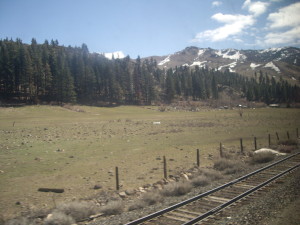Past Perfect tense verbs – They let you relate events in the past that occurred during another past event. This is what you’ll learn today on Ramping Up your English. You can watch Episode 4 on this link. You can also watch Episode 4 and download it by clicking here.

View by segments: Segment 1. Click here for Segment 2. Click here for Segment 3.
Free Download: You can watch this episode ad-free and even download it. Click here to see it on archive.org
Episode 4 focused on the building of the railroad in Southern Oregon. The language objective was to use past perfect tense verbs to show the relationship between two events that happened at different times in the past. We also reviewed basic conjunctions.
Academic Content Objectives: Transportation: Relate effects of the Transcontinental Railroad on Rail development in the Pacific Northwest. History: Explain the effects of the Transcontinental Railroad on settlement of the West.
Relationship between these facts:
The Transcontinental Railroad was completed in 1869, linking the East Coast with the West Coast. There was no railroad joining Southern Oregon to the East coast until 1883.
Using Past Perfect Tense:
They had already built the Transcontinental Railroad in 1869, linking the East Coast with the West Coast; but there was no railroad in Southern Oregon linking it to the East Coast until 1883.
Another way of saying the same thing:
The Transcontinental Railroad had already been built 14 years earlier, when Southern Oregon was finally connected by rail in 1883.
Past Perfect Tense:
Present = build Past = built Past Perfect: had built Participle=built
Participle MUST have a helping verb, for example: had.
The verb build uses the participle “built,” which is the same as the past tense.
For some words, the participle is different:
Present = throw Past = threw Participle = Thrown
He had thrown the spike to the worker, but it was too dark for the worker to catch it.
If he had thrown the spike during daylight, the worker would have caught it.
For a larger list of participles, I suggest you Visit English Page.com. That link will also show you more of the nuts and bolts of English grammar.
Here are the video clips used in Episode 4:
Add-Free Viewing
The same clips are now available on Archive.org, where there are never ads.
The links below also take you to the clips:
Notebook
Be sure to start your notebook dedicated to this course if you haven’t already done so. See Episode 3 for a quick look of what’s already been entered in the notebook.
Homework
Use your notebook for keeping all your homework. This episode, recall two past events that are related to each other (first child; second child or kindergarten first day; 5th grade first day). Use one of the listed past participle verbs to show how the events are related to each other. Write 2 sentences. This is pretty advanced stuff!
Learn about the history of railroad unions and their influence on the great Union Movement in U.S. History in Episode 5. Find all 32 Episodes in the Trains and Railroads unit on the Home Page.
